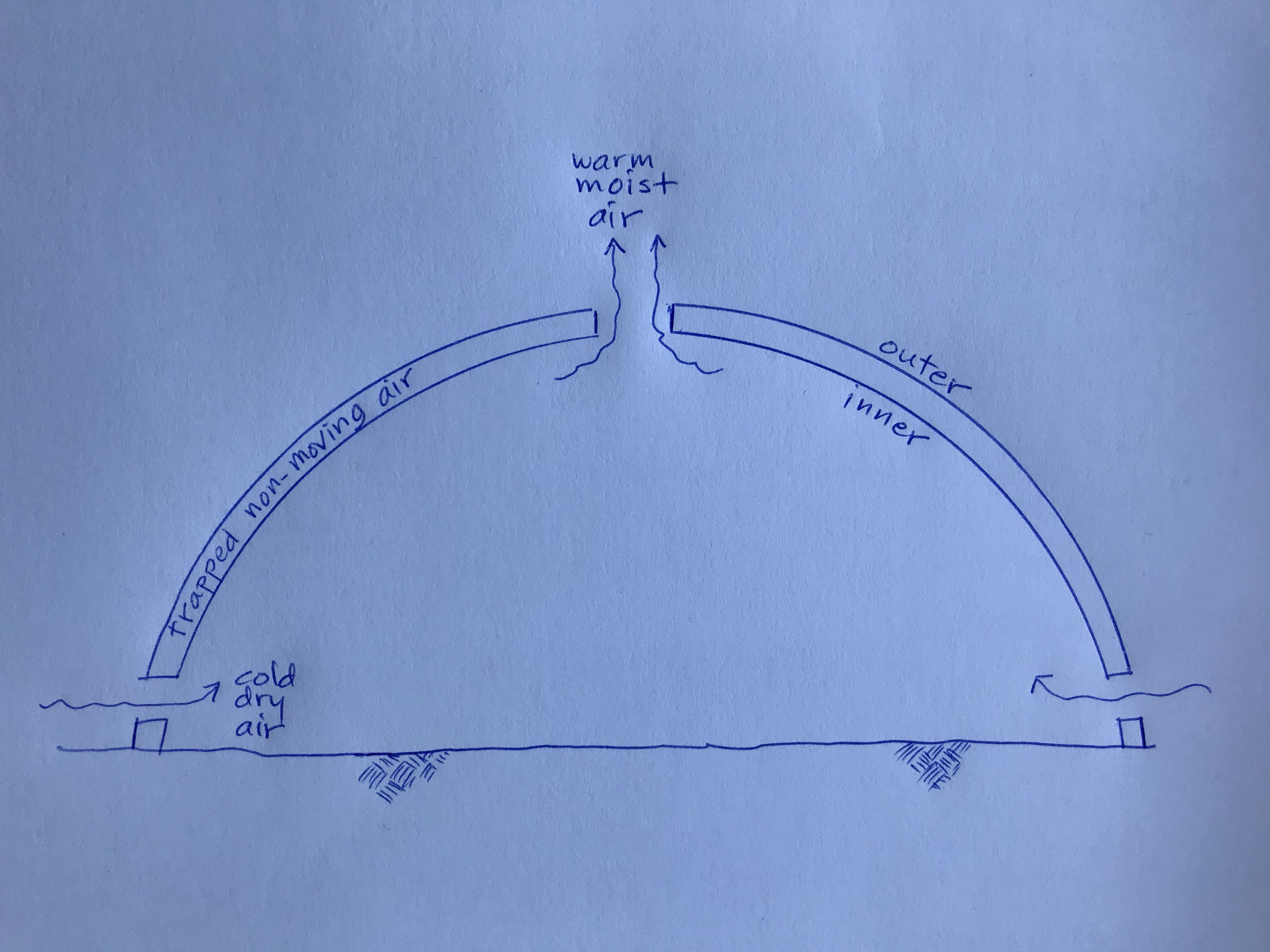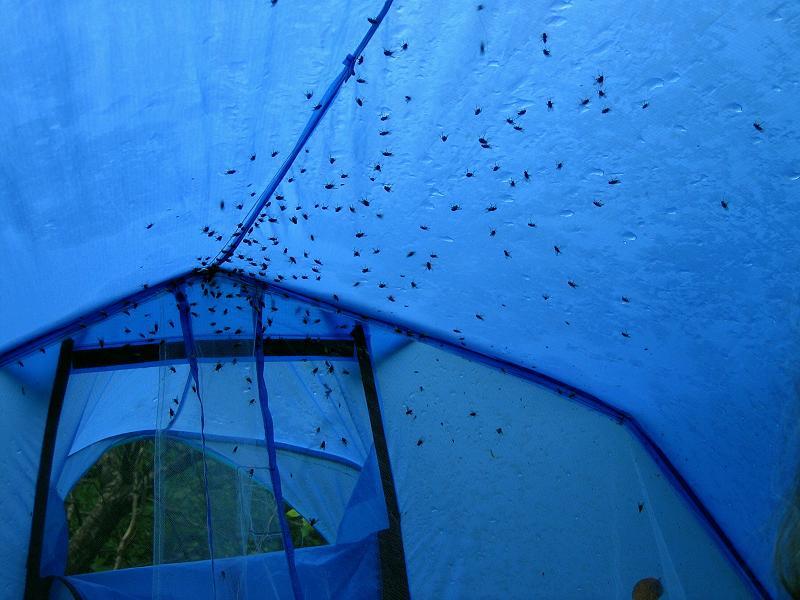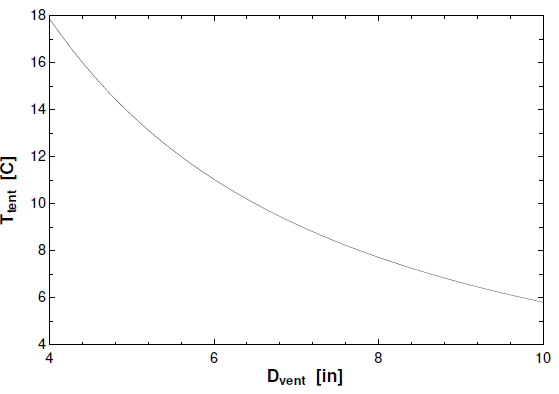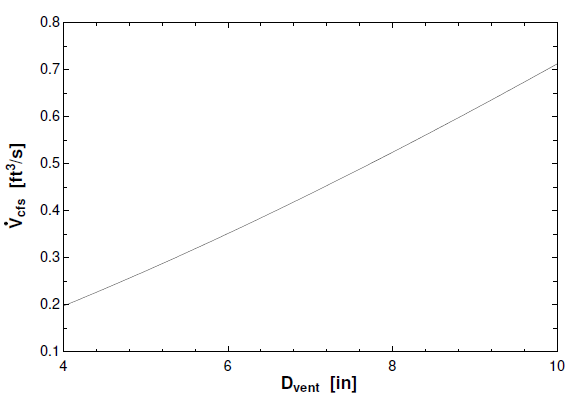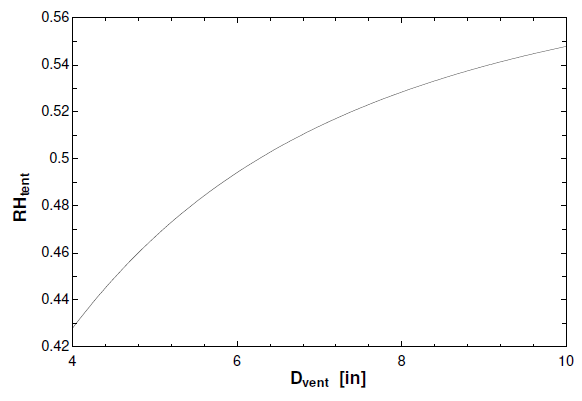Topic
single vs double wall in frigid conditions
Forum Posting
A Membership is required to post in the forums. Login or become a member to post in the member forums!
Home › Forums › General Forums › Winter Hiking › single vs double wall in frigid conditions
- This topic has 73 replies, 15 voices, and was last updated 3 years, 5 months ago by
 Eric Blumensaadt.
Eric Blumensaadt.
-
AuthorPosts
-
Oct 28, 2020 at 9:57 am #3681406
Traditional 2-wall tent has permeable/breathable inner and impermeable outer/fly.
I believe the Warmlite system, and what I had in mind, is that both inner and out are impermeable/do not breath. Air does not circulate between them. The air in between acts as an insulating layer so that the inner wall is warmer than the outside air.
Oct 29, 2020 at 10:57 am #3681537Yeah, this is the part that confuses. I thought Roger had straightened me out. If the air is an insulating layer. Moving it through natural convection would increase heat transfer. That is the entire purpose of down in your sleeping bag. Those little feathers conduct heat better than air. They are there precisely to prevent the air from moving around.
So why do we want natural convection in a Warmlite system?
Oct 29, 2020 at 11:56 am #3681539The Warmlite convection is cold dry air from outside drawn low into the tent where it warms up, then rising warm moist air inside venting high to outside. There is no air circulation between the inner and outer walls of the tent, so that it will act as an insulating layer of dead air space. Hopefully this sketch will help explain:
 Oct 29, 2020 at 2:18 pm #3681562
Oct 29, 2020 at 2:18 pm #3681562Nice sketch! Given that design, how does the (trapped) air get in and out of the two impermeable layers? Might it get inflated like an air mattress?
Oct 29, 2020 at 2:38 pm #3681564I did review a Warmlite tent sent to me some time ago.
The design puzzled me a bit. It almost seemed that whoever made the one I saw had copied without understanding the original, and got parts of it wrong. In fact, a lot of it made no sense at all.Cheers
Oct 29, 2020 at 3:38 pm #3681568Matt: I wouldn’t expect the trapped layer to be absolutely air tight, especially after a bit of normal use, but tight enough to prevent free air flow from either side. Inflated like a mattress in some sense is one of many possibilities. You wouldn’t want to blow it up with your breath and trap all that moisture in there, but something like a Nemo Tensor inflating bag would work. It would be kind of a drag to have to actively inflate it at all, and some passive, or nearly passive, method would be better. Maybe short waterproof zippers for each “chamber”? Open while the tent is pitched, then closed?
Roger: I’ve read in a number of places that Stephenson’s isn’t what it used to be, since the patriarch retired. But he had a lot of innovative concepts, and some might work better now with modern materials and better workmanship.
Oct 29, 2020 at 4:55 pm #3681575‘Modern materials’ I am happy to accept.
‘Better workmanship’ however is NOT what I saw. Sorry.Cheers
Oct 29, 2020 at 5:15 pm #3681577Roger, I didn’t mean to say the Warmlite is better. Just that some of Stephenson’s ideas might work better with modern materials and better workmanship, regardless of who makes them.
Oct 29, 2020 at 5:36 pm #3681586Oh – I misunderstood. But I still disagree.
The single windward anchor is, to my mind, a dangerously bad idea. It is a single point of failure. I put no less than four windward anchors into my tunnels.
The lack of a vestibule for gear and cooking might be OK for a single night as an assault tent, but I think it is a lousy decision for a week-long walk at altitude for 2 people. Been there, done that, many times. You need the space.
The groundsheet seemed to be sewn to the inner wall with a single line of stitching. And the stitching in places was wobbly. I was amazed.
The front door has two zips on each side – for absolutely no visible reason. To be sure, it makes for a wonderful overlapping seal – except that you don’t need it at the lee end.
The idea that the air trapped between layers might act as a useful insulator is nice on paper, but it fails totally in the real world. The trapped air will lose heat so fast to the outer layer it isn’t funny. If it worked we could expect Michelin Man sleeping bags.
I could go on, with photos, but I won’t.
Cheers
Oct 29, 2020 at 6:21 pm #3681594I don’t disagree. Some of his ideas suck, and recent fabrication is worse.
But some of his ideas are interesting.
I don’t disagree that the trapped air is not a great insulator. But unlike a sleeping bag, which must be capable of maintaining some specific minimum temperature so the occupant doesn’t get hypothermia, the tent only needs to maintain some differential between inside and outside sufficient to drive convective ventilation. 5°? 10°?
I don’t know what that differential is, or if tent walls with trapped air can achieve it. But I think the idea is worth looking into because if it works the possible benefits are great and the drawbacks minimal.
And since the inner is impermeable there are other possibilities, such as the walls having an optional down-filled layer (maybe 1” with total amount of down for the whole tent about the same as a sleeping bag) and/or IR reflective inner surface to increase the differential.
Unconventional and unproven for sure, such that I don’t realistically expect anyone else to invest the money, time and effort to prototype and test it. Maybe when I retire.
Oct 29, 2020 at 7:16 pm #3681602Hi David
My experience has been that the inside of my single-skin tent with 2 occupants can be 3+ degrees C warmer than the outside. Not much, but nice to have.
My double-skin tent can fairly easily be 5 C warmer than outside, in the snow, with 2 occupants. The inner tent in this case is plain fabric, no coating.
In both cases, getting out of the wind is an enormous help of course. Knowing that the tent WILL stay up in most any wind (100 kph) also helps.
Now, the idea of a padded inner tent is not new, and has been discussed before here at BPL. The problem with the idea is that it is hugely inefficient in weight compared to the same thickness layer in an over-quilt. Perhaps if one was living in the tent all day for several days rather than walking it might be of some use?
Cheers
Oct 29, 2020 at 8:11 pm #3681606So Ben,
Do we have enough information to make a reasonable calculation yet?
5 C temperature differential inside vs. outside
Impermeable inner tent.
And:
1. 2P Half Dome shape like the Black Diamond FirstLight, with 100 sq. in. of intake vents no more than 4 in. above the floor and 50 sq. in. of exhaust vent at the peak.
or
2. 3P Full Dome shape like Kelty Towpath 3 Tent or North Face Stormbreak 3 (with flies), with 150 sq. in. of intake vents no more than 4 in. above the floor and 75 sq. in. of exhaust vent at the peak.
Oct 30, 2020 at 9:19 am #3681653Hi David,
Thanks for the drawing. Hopefully now I have a better understanding what you are looking for. So we have a heat source in the tent (people) driving natural convection. A tent with great ventilation would dump everything out making the inside of the tent the same temperature as the outside of the tent… too cold. So you want to size the ventilation to allow enough moisture to escape (preventing condensation) but small enough to allow the tent to heat up.
Ok so the variables (inputs) would be the heat source (number of people or how much total heat they are rejecting), outside temperature, desired inside temperature. The output would be the size of the vent. That is the heat transfer/fluid dynamics. But on the condensation side you would want to check to see if the inner wall of the tent is below dew point (output). The additional inputs needed would be outside air humidity and how much moisture the people are adding.
Does that sound like the type of analysis that would be helpful to you (inputs/outputs)? I know I ask a lot of questions but the analysis is a bit complex. I enjoy helping DIYers but I want to make sure whatever I do is useful.
My plan is to sketch out a solution and solve on an engineering tool I have. I’ll present those results here and if they look good to you I can implement them on an Excel spreadsheet. How does that sound?
I’m always full of questions, so I’m going to ask another: do you think a key aspect of the Warmlite design is that the incoming cold air is trapped along the wall of the tent and never really mixes with the air the people “feel”? Or does the cold air mix with the air in the tent and a mixture of that air is vented out?
Oct 30, 2020 at 11:56 am #3681683“So you want to size the ventilation to allow enough moisture to escape (preventing condensation) but small enough to allow the tent to heat up.”
Right
“Ok so the variables (inputs) would be the heat source (number of people or how much total heat they are rejecting), outside temperature, desired inside temperature. The output would be the size of the vent. That is the heat transfer/fluid dynamics. But on the condensation side you would want to check to see if the inner wall of the tent is below dew point (output). The additional inputs needed would be outside air humidity and how much moisture the people are adding.”
Yes
“Does that sound like the type of analysis that would be helpful to you (inputs/outputs)?”
Exactly
“I know I ask a lot of questions but the analysis is a bit complex. I enjoy helping DIYers but I want to make sure whatever I do is useful.”
Really appreciate your help. Happy to answer any questions.
“My plan is to sketch out a solution and solve on an engineering tool I have. I’ll present those results here and if they look good to you I can implement them on an Excel spreadsheet. How does that sound?”
Perfect
“Do you think a key aspect of the Warmlite design is that the incoming cold air is trapped along the wall of the tent and never really mixes with the air the people “feel”? Or does the cold air mix with the air in the tent and a mixture of that air is vented out?”
I don’t think incoming air is trapped against the inner wall of the tent, I think it mixes with interior air and is vented out.
Oct 30, 2020 at 2:43 pm #3681705Need some fresh air for breathing.
Cheers
Nov 1, 2020 at 8:18 pm #3681953I am not following the logic of this thread. The statement “The air in between acts as an insulating layer so that the inner wall is warmer than the outside air” seems to indicate that such a layer mitigates the loss of heat through radiation from the warm human bodies inside the tent into the outer ambient environment. I always thought the function of double walls was 1) somewhat better ability to manage condensation and 2) somewhat better protection against loss of heat through convection, the wind blowing across your tent, the 5 degrees Celsius warmer than ambient referenced by Roger above.
Nov 1, 2020 at 9:12 pm #3681957With a traditional double wall tent a porous inner wall doesn’t do anything to reduce condensation as a whole within the tent as a whole. It just lets the condensation form on the outer wall, and the inner wall keeps the occupants from brushing against it.
In the traditional design what reduces condensation on the inside of the outer wall is the air circulating between the walls. Reducing condensation requires circulation of outside air between inner and outer walls, but that cools the interior, reducing inside vs. outside temperature differential and requiring thicker insulation for the occupant(s).
And in perfectly still air there is very little if any venting of warm, moist air. Convection is limited by height difference between in and out vents, difference in height between tent peak and highest vent, and difference between inside and outside temperatures. In-vents should be as close as possible to the ground. Out-vents ideally at the peak.
Combined with enough temperature differential you can drive “passive”convective air exchange to minimize condensation, even in dead calm conditions. With a breathable inner wall you can’t get enough temperature differential to make it work.
Nov 1, 2020 at 9:26 pm #3681962@Bruce: the inner tent also blocks any residual spindrift coming in. This can be rather important in a winter snowstorm.
@David: Just so, although my winter tent has the option of intake at ground level in mild conditions, when the sod cloth is rolled up, and an intake at the windward peak when the sod cloth is rolled out and weighted down – like in a storm. I have a hood or verandah over the top inlet to keep rain out, and the inlet can always be sealed up.What I do NOT do is seal both inlets at once! That way lies huge problems with condensation. (How do I know?)
Cheers
Nov 2, 2020 at 11:41 pm #3682092It seems like the “optimized condition” that we all seek is rather narrow and dependent upon:
- temp
- humidity
- wind
what happens then when actual conditions deviate?
- ultra-cold, RH 100%, no wind?
- extreme winds, and who cares about rh% and temp? tent falls down, ie.
- super-hi rh%, no wind, high temps, lots of bugs? ugh. 😩
Give me a tent that is solid when it needs to be (no leaks, wind stable in extreme weather), and I’ll sort out the rest (bugs, condensation, frost, snow loading) as it comes I suppose.
The “perfect tent” only exists in one “perfect condition”. And then what, when the (normal) deviations occur?
@rcaffin is right in pointing out the curious design considerations of Stephenson tents, and yes, we’re all a little confused about poor seam quality for the $ (although admittedly, I’ve used them for years with no issues (seam failures) even in extreme conditions {+ heavy snow and winds > 50 mph} on mountaineering trips), but let’s get back to performance:weight ratio. Wind-stable in extreme winds? A tunnel with more guy-outs is better. Snow-stable under extreme loads? Geodesic 3-pole crossing designs have it beat. Ventilation and condensation? Only OK in ++ wind and w/VB bags. So, versatile? Probably not.Nov 3, 2020 at 12:27 am #3682097ultra-cold, RH 100%, no wind?
That depends on the actual temperature. At or below 0 C air contains very little moisture, so 100% RH is not really a problem. There won’t be anything significant to condense out.extreme winds, and who cares about rh% and temp? tent falls down, ie.
I think my experience there with my tunnel tents is well-known. When there is a lot of wind condensation rarely forms: it gets swept away.super-hi rh%, no wind, high temps, lots of bugs? ugh.
Could be bad, but my experience has not been too much of a disaster. After all, no wind and high temp means you can have both ends of a tunnel wide open. With a pop-up it is another matter, unless it has doors on both sides which can be opened right up. But then, a tarp might suffice under those conditions – except for the bugs. Need a bivy as well.
Medium temp, no wind (thick forest), high RH, millions of gnats, GR5 in France. Sigh. But they turned out to be very keen on the blue fabric and sitting right up high – UV-seeking maybe. I whooshed most of them out when the sun went down by opening the netting doors very wide and waving my hat.
Cheers
May 26, 2021 at 3:38 pm #3714357David,
I know this thread is pretty old, but I haven’t forgotten about it! I started sketching out the equation and got confused (I blame having spent too much time in management). I came across a problem at work that reminded me about this. Now I’m back at it. I’ve got a good start on the heat transfer. Now I am adding in the humidity calculations. I should be able to get some results to you soon.
May 26, 2021 at 5:13 pm #3715278No worries Ben. Looking forward to it.
May 28, 2021 at 8:48 am #3716148Ok, this is a really fun problem but its gets complex quickly. I want to discuss what I have done with you but I want to try not to get you too lost. I’ll try words first. I can post equations if you would find that helpful.
Model
Heat is released by people in the tent (70-80 watts per person while sleeping from a quick google search). The heat warms the air and buoyancy forces create a temperature differential and pressure differential across the tent (top to bottom). That pressure differential across the vent of the tent controls the flow of air. That is a solvable set of equations (3 equations/3 unknowns). You are solving for temperature differential, pressure differential, and air flowrate.
Humidity
The incoming air is at some ambient temperature and humidity. It warms up in the tent but the people also add moisture (40 grams per hour per sleeping person based on a quick Google search). The resulting air is warmer and contains more air. The sample calculation I did shows the relative humidity actually goes down slightly (because warm air can absorb more moisture). To determine if condensation occurs I have to compare the dew point of the hot moist air in the tent to the temperature of the insulated wall. I am in the process of modeling the tent wall to make that calculation.
Sample Calculation
Inputs
outlet vent = 50 in^2
inlet vent = 100 in^2
height of the tent = 1 meter (semicircle)
length of the tent = 2 meters (I know that is short, but I am using it to estimate heat loss area and most tents narrow near the foot end)
thickness of double-wall = 3 inches
ambient temperature = 0 celcius
ambient humidity = 60%
heat input = 2 people x 80 watts
moisture input = 2 people x 40 grams/hour
Output
Tent temperature = 7.7 celcius
tent relative humidity = 53%
air flow rate = 0.0186 kg/s (sorry for the units… it’s easier for the calculation. I can convert it to any unit you might like)
pressure differential = 0.35 Pa
If you want different conditions please let me know. I’ll keep working on the wall dew point stuff.
May 28, 2021 at 10:38 am #3716163This is great Ben. Really appreciate your work! A few thoughts:
1. “The resulting air is warmer and contains more air.” Type? You mean warmer air contains more moisture, right?
2. You’re modeling a tunnel, and I had in mind (a) a hemisphere shape like a dome tent to minimize surface area vs. volume, or (b) roughly 1/2 of a 2:1 oblate spheroid sliced through axis like a crossing two-pole half-dome tent of the Bibler/BD FirstLight type.
3. 50 sq. in. for the exhaust works out to an 8″ diameter vent, which seems kind of large. If it’s not too much extra work I’m curious how 7″ and 6″ exhaust vents would work.
4. 100 sq. in. for the cold air intake is less that I was thinking. Could you also check how 200 sq. in. would work?
5. Although I typically calculate air flow rate in 0.0186 kg/s (NOT!) it would be nice to see CFS too please.
Thanks!
May 28, 2021 at 1:00 pm #37161831. yup
2. Changes made. What height (or radius)? I stuck in 1 meter as a placeholder… seems a tad short to me.
3. see plots below
4. change made, though at this stage I am assuming flow is controlled by the outlet vent, so this doesn’t change the analysis at all.
5. done!



-
AuthorPosts
- You must be logged in to reply to this topic.
Forum Posting
A Membership is required to post in the forums. Login or become a member to post in the member forums!
Trail Days Online! 2025 is this week:
Thursday, February 27 through Saturday, March 1 - Registration is Free.
Our Community Posts are Moderated
Backpacking Light community posts are moderated and here to foster helpful and positive discussions about lightweight backpacking. Please be mindful of our values and boundaries and review our Community Guidelines prior to posting.
Get the Newsletter
Gear Research & Discovery Tools
- Browse our curated Gear Shop
- See the latest Gear Deals and Sales
- Our Recommendations
- Search for Gear on Sale with the Gear Finder
- Used Gear Swap
- Member Gear Reviews and BPL Gear Review Articles
- Browse by Gear Type or Brand.

